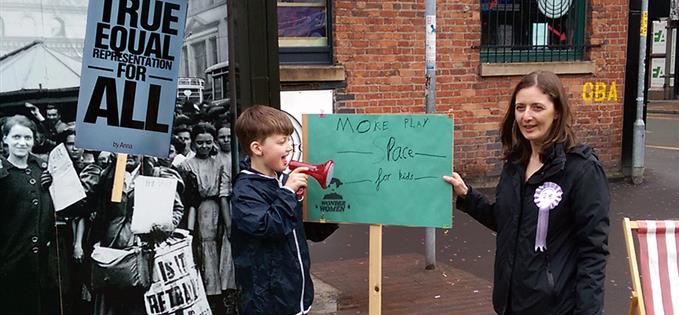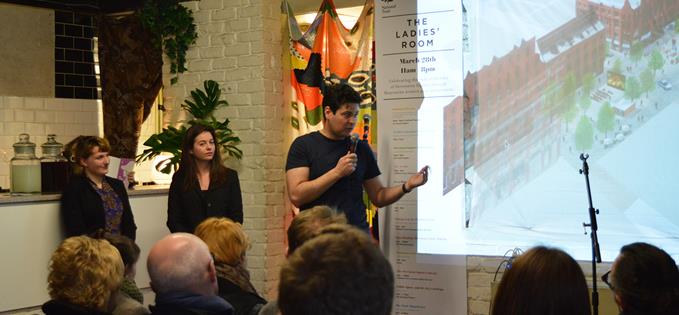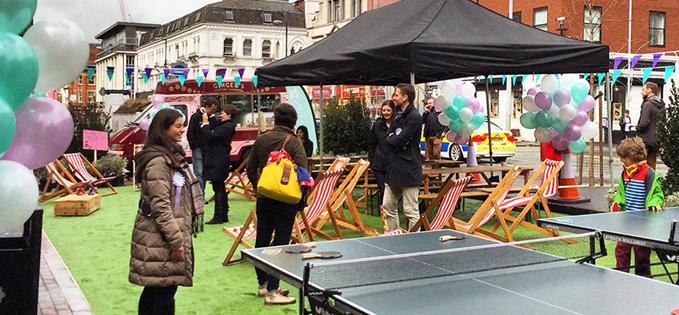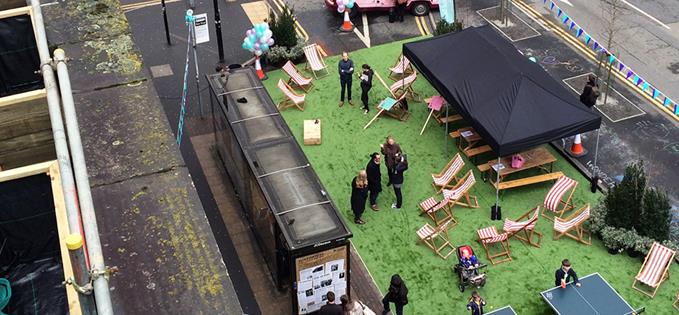“I’LL MEET you at Stevenson Square,” she said. “It’s right in the middle of the Northern Quarter. Just head toward Shudehill from Piccadilly, you can’t miss it.” So there I was, fresh off the train, setting off in search of this central piazza paved with gold. And walking right through it. And back again. And back, again.
We want to re-imagine the square as a non-prescribed canvas for creativity; a platform for the Northern Quarter
For, when is a square not a square? Well, when it’s a rectangle for a start. When it’s a rectangle with no discernable borders, no corners, no beginning and no end, it’s arguably more of a through-route. Throw in a few bus lay-bys, a weird archipelago of randomly placed concrete islands, add in a few visibility black-spots, a couple of difficult to navigate junctions and a job lot of conflicting traffic signs and hey presto! You’ve got a life-size version of Frogger, but the only thing even nearing any kind of piazza here is a nice bit of Slice’s cafe’s calzone.
Public squares are an important part of a city’s fabric. They are social spaces, increasingly needed in ever-more anonymous urban environments, dominated by faceless apartment blocks, providing human interaction and recreation, and often hosting trees and green space for aesthetics and, you know, oxygen.
Many, like Stevenson Square – have historically been centres for public gatherings, and, naturally, for protest. Contemporary cultures continue to gather in central squares across the world – Times Square, Red Square, St Peter’s in Vatican City, with Tiananmen, Tahrir and Euromaidan all of course of massive global political significance. It is unsurprising perhaps to note that the state-led designs for a new capital city in Egypt has no squares.

And it’s not that Manchester can’t do a good square. There’s Albert Square and the Town Hall, so wonderfully brought to life during MIF and the Spanish/Irish/German/Tasmanian festivals, St Ann’s Square with its iconic cotton-bud fountain, and the beautifully done St Peter’s Square (below) with the relocated Cenotaph – amongst others.

Stevenson Square was in fact designed to rival St. Ann’s Square, passing ownership from Sir Ashton Lever, owner of … everything at the time, to William Stevenson in an 18th century hot MIPIM deal. Thanks to that, it actually has the same layout and dimensions as St. Ann’s, but yet feels like an entirely different space, and for all the brilliant artwork, let’s not forget that the focal point in Stevenson un-Square, is without its window-dressing, a disused toilet.
Last weekend, The National Trust’s ‘Wonder Woman’ festival presented ‘The Ladies’ Room’, a series of events in and around Stevenson Square both celebrating its radical history (Suffragettes, Suffragists and anyone with a spare placard gathered there),and considering its future potential as a public space. Undeterred by the rain, people flocked to the astro-turf to hit the soggy deckchairs and enjoy a game of aqua-table tennis, and a quick chilled cider from the bus-stop bar; a veritable Costa del Shudehill.
Local practices Planit-IE Architects and Civic Engineers were approached by festival organisers to create a design concept for a revived and re-animated Stevenson Square, giving thought to how it might work as a shared space, for which they produced this beautiful piece of design, presenting it to a captivated audience in the old Koffee Pot.
Naomi Burl from Planit-IE explains their thinking: “Historically Stevenson Square was a place where people expressed themselves and their aspirations, through marches, rallies and protests. We want to re-imagine the square as a non-prescribed canvas for creativity; a platform for the Northern Quarter to convey its independent and quirky character – a Place for People.”

But most telling for me were the questions. “Have residents been consulted on this?” asked one. BAM. The danger of ideas. “How much is this going to cost?” asked another. KERCHING. It’s all about the Benjamins, baby. “How do we make this happen?”, asked a third. “Write to your local Councillor,” the reply. KAPOW. Viva la revolución.
Because nothing can happen without a client. Just around the corner, in another Planit-IE design, a space at the centre of The Co-operative’s NOMA development will be transformed in to ‘New City Square’ bringing – yes – some actual green space to the city centre.
But with no NOMA and no money, and with good old Sir Ashton and Big Billy Stevenson long gone to the MIPIM in the sky, the onus is on public money to support something – anything - happening.
As Stephen O’Malley, Director of Civic Engineers, acknowledges, sadly that’s in short supply:”Our streets and squares are public spaces and while they belong to all of us they remain the legal responsibility of the Local Authority. We all know how limited the public purse is, so we need to think of more creative ways to fund and deliver fresh cityscapes whilst collaborating closely with the officers and agencies managing our city networks. Manchester has a pedigree and an appetite for innovation, let’s see if we can develop a new model with the City for realising vibrant, versatile and beautiful city spaces.”

Surely, for Stevenson Square – home of radicalism, protest and people-power, at the epicentre of the Northern Quarter – with all of its creative capital, cutting edge design thinking and technical expertise – we can come up with a way to make this happen.
What if we were the client?
Down in the London, there’s an initiative at the moment led by Theatrum Mundi and the London Festival of Architecture asking people – not necessarily architects or design professionals – but citizens at large – to nominate pieces of land as ‘commons’. A common: a piece of land owned by someone but with the ‘right to roam’ for others. Or a village green, ‘for sport and recreation’ where you can also graze livestock. [I imagine one J Schofield might try his hand at this] [and Gordo would eat them].
We wanna square like common people.
Can we build on the momentum of the Wonder Woman festival, and the design provocation put forward by Planit-IE and Civic Engineers, as a platform to galvanise the Northern Quarter spirit and come together as ‘the client’ in a co-designed, crowd-sourced, crowd-funded, collaborative approach to Stevenson Square’s development? Actual development, not just letting the crazy creatives play table-tennis for the afternoon, but creating something real, something quintessentially Northern Quarter – not over-sanitised or over-civic, but forward-thinking, creative, dynamic, of the place and that the Northern Quarter and Manchester – can be proud of.
Surely, that’s a better way to square it?
I’m in if you are.
Clare Devaney is a Fellow & Associate of the Royal Society of Arts, and a proud resident of the Northern Quarter. @ClareDevvo
















